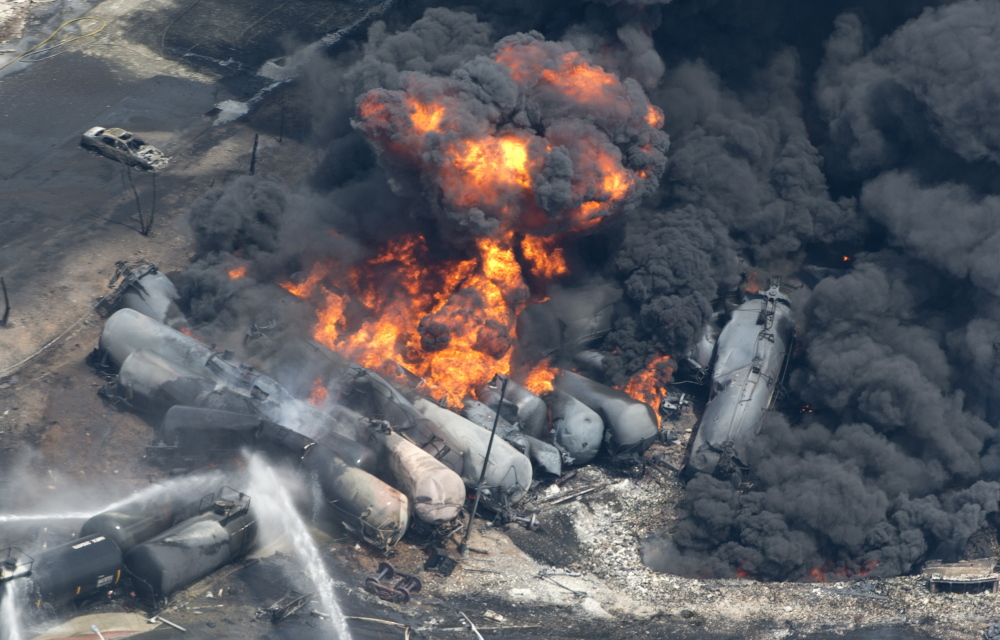Families of the 47 people killed in the 2013 derailment in Lac-Mégantic, Quebec, would split nearly $86 million from a settlement fund of more than $330 million, according to a disclosure statement that has been approved by a federal bankruptcy judge in Maine.
Creditors of the Montreal, Maine & Atlantic Railway will vote on the settlement in September.
The victims, including the surviving family members, those injured in the crash, those who suffered economic and property damage, insurance companies and the governments of Lac-Mégantic and Quebec, already have approved the settlement plan.
Approval by the creditors would release the payments and end the railway’s two-year bankruptcy case.
Despite initial objections by some parties to the case, the details of individual victim settlement agreements will be withheld from the public, including the share of funds that will go to victims’ personal attorneys as contingency fees.
To include that information in the disclosure statement would violate the privacy of victims and potentially jeopardize dozens of individually negotiated settlements, according to Portland attorney Robert Keach, federally appointed trustee for the now-defunct railroad operator based in Hermon.
“We would have to disclose the private contracts of the constituency of victims without their permission in order to give the very people who signed the agreement notice of their own agreement,” Keach argued in a hearing Wednesday before U.S. Bankruptcy Judge Peter G. Cary.
On July 6, 2013, an MM&A train pulling 72 oil tankers rolled driverless down a slight incline into Lac-Mégantic while the train was unmanned overnight. The tank cars began to derail in the downtown area, spilling an estimated 1.5 million gallons of crude oil and causing an explosion that killed the 47 people and destroyed 40 buildings.
Regulatory agency Transport Canada later determined that an insufficient number of hand brakes had been applied to the train when the engineer left it unattended for the night just outside of town. It also said the hand brakes had not been tested properly.
In 2014, three railway employees were charged with 47 counts each of criminal negligence, including engineer Thomas Harding, who was accused of failing to set enough brakes on the train. MM&A also was charged. In June, additional charges were filed against Harding, the railway, CEO Robert Grindrod and manager of train operations Jean Demaitre.
A month after the disaster, MM&A filed for protection from its creditors under Chapter 11 of the U.S. Bankruptcy Code.
The 473-page disclosure statement approved Wednesday lays out how different classes of victims would be compensated. All monetary figures in the statement are in Canadian dollars. As of Thursday, $1 Canadian was worth 77 cents in U.S. currency.
Payments to family members of victims killed in the crash would be based on a points system that the disclosure statement describes in detail. It allocates points for each family member killed based on factors such as the victim’s age, whether he or she is survived by a spouse or children, and the victim’s annual income.
The purpose is to compensate family members based partly on each victim’s former financial contributions.
Parents of a child killed in the crash would receive far fewer points than the widow or widower of a middle-aged victim who had been earning $100,000 a year.
The disclosure statement also lists the number of family members to be compensated, how many points were allocated to each, and how much money they would be paid.
In all, the family members each would receive between $478,000 and $5.4 million Canadian, or $369,000 and $4.2 million U.S.
The disclosure statement does not include personal information about those killed in the derailment or their survivors.
In addition to the $111 million Canadian ($85.7 million) that would go to family members, about $48.8 million Canadian ($37.4 million) would be divided among living victims who suffered injuries and/or psychological trauma. Property and economic damage claimants would receive $75 million Canadian ($57.9 million), and more than $16 million Canadian ($12.4 million) would go to insurance companies.
The governments of Lac-Mégantic and Quebec would receive more than $191 million Canadian ($147.4 million) for environmental cleanup and rebuilding efforts.
More than $20 million Canadian ($15.4 million) would be set aside for the lawyers involved in the bankruptcy case.
Send questions/comments to the editors.





Comments are no longer available on this story